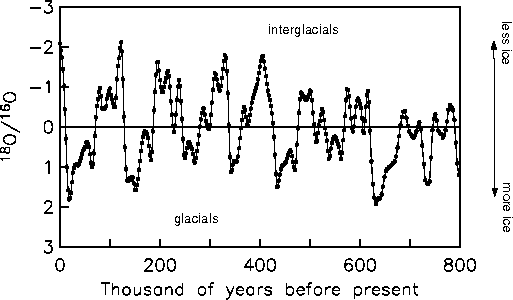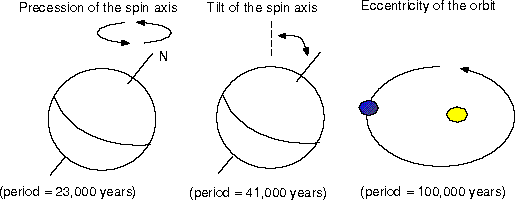
This link will take you to the source material for this part of the lecture. It is so good, I can't compete:
http://nsidc.colorado.edu/NSIDC/general_pamphlets/glaciers.html
By carefully considering the geological evidence, scientists deduced that there were at least four glaciations in the past, not just the last one. The problem is that glaciers tend to erase the evidence of earlier events. Therefore, in order to study past glaciations effectively, we need a better record than that left on land. Naturally, we turn to the sea.
Glaciations also leave their mark in the sediments blanketing the sea floor. For one thing, ice bergs carry with them gravel (even boulders), which drop to the bottom when the ice berg melts. These so-called "drop stones" are a clear indication of the presence and extent of sea-ice.
A much more subtle effect can also be detected. The water molecule is composed of two hydrogens and one oxygen atom. Because the Oxygen-16 isotope is lighter than the Oxygen-18 isotope (both common in natural waters), oxygen-16 evaporates more readily. For the same reason, clouds rain out the heavier isotope more readily. Therefore clouds become enriched in the lighter isotope of oxygen. By the time the clouds reach the polar ice caps, they are very enriched in the light isotope form of water and the snow captured by glaciers locks up this form. The oceans on the other hand, become enriched in the heavy isotope of oxygen. Calcite shells of plankton are made of CaC03 and reflect in some way changing concentrations of the oxygen isotopes. Therefore as glaciers grow and subside, the changing volumes of ice (hence light oxygen isotopes), are recorded in the sediments of the world's ocean.
Here is a nice record of oxygen isotopes obtained for the last 800,000 years:

Examining the above picture, you can see the complete record of of all the glaciations for the last 800 years. In fact, there are nine glacial intervals, many more than the four detected from the land-based record. Actually, there are many more than that, going back some two and a half million years. Prior to that, there was no permanent ice in the norther hemisphere.
You might also notice that the pattern of glacials and interglacials is quite rythmic. Careful analysis of the record reveals that the curve is really the sum of three curves, pulsing at 100, 40 and 20 thousand year intervals. What drives these curves?
It turns out that the pulses of glaciation correspond to variations in the Earth's orbit around the sun, matching the amount of heat insolation reaching northern latitudes in the summer. The Earth's orbit is not a perfect circle, nor is the tilt with respect to the sun constant.

Like a top, the axis of rotation (the spin axis) precesses around in a circle. It takes about 26,000 years to complete one rotation. This results in the position of the equinoxes to change with a period of about 23,000 years. Also, the tilt of the spin axis (obliquity) with respect to the ecliptic (the plane in which the earth rotates about the sun) changes. It varies between about 24.5 and 21.5 degrees. (Now it is some 23.5 degrees). This variation in tilt has a period of about 41,000 years. Finally, the degree of ovalness (eccentricity) of the Earth's orbit changes from more circular to more oval (elliptical). This variation has a period of about 100,000 and 400,000 years.

For further browsing pleasure, check out these very nice links:
http://tvl1.geo.uc.edu/ice/glacier.html
http://mole.uvm.edu/whale/GlaciersGlacialAges.html
http://museum.state.il.us/exhibits/larson/glaciers.html
http://museum.state.il.us/exhibits/larson/environments.html
Back to Top
Back to Syllabus Page
Back to Home Page
ltauxe@ucsd.edu